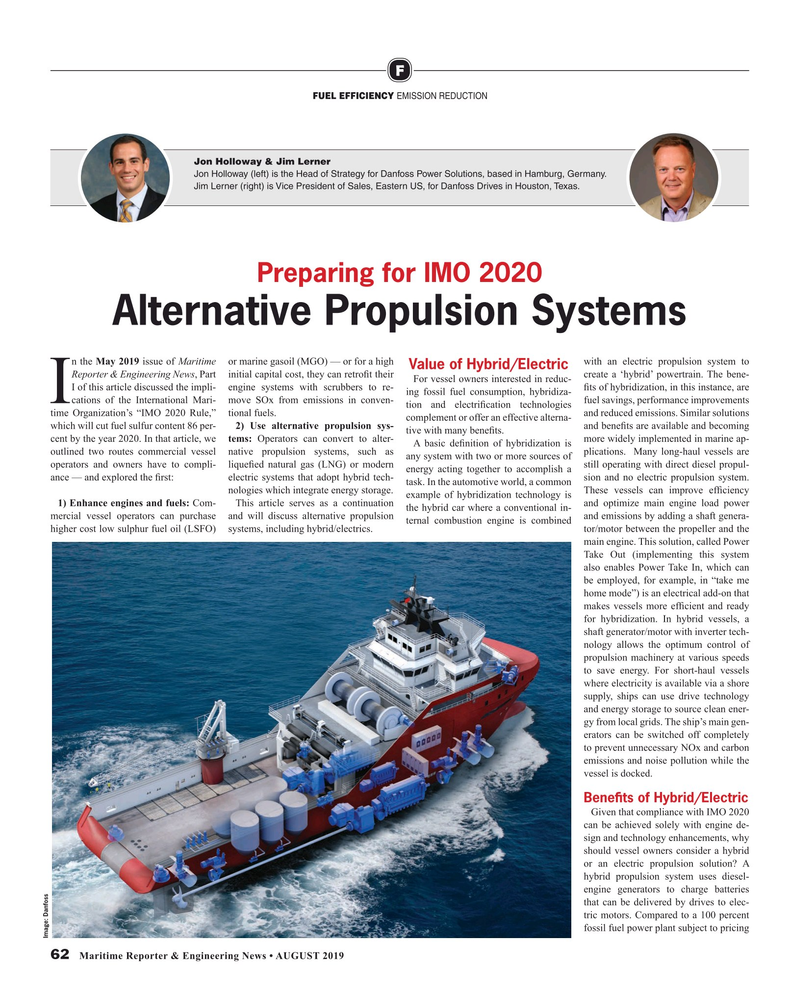
Page 62: of Maritime Reporter Magazine (August 2019)
The Shipyard Edition
Read this page in Pdf, Flash or Html5 edition of August 2019 Maritime Reporter Magazine
F
FUEL EFFICIENCY EMISSION REDUCTION
Jon Holloway & Jim Lerner
Jon Holloway (left) is the Head of Strategy for Danfoss Power Solutions, based in Hamburg, Germany.
Jim Lerner (right) is Vice President of Sales, Eastern US, for Danfoss Drives in Houston, Texas.
Preparing for IMO 2020
Alternative Propulsion Systems n the May 2019 issue of Maritime or marine gasoil (MGO) — or for a high with an electric propulsion system to
Value of Hybrid/Electric
Reporter & Engineering News, Part initial capital cost, they can retro? t their create a ‘hybrid’ powertrain. The bene-
For vessel owners interested in reduc-
I of this article discussed the impli- engine systems with scrubbers to re- ? ts of hybridization, in this instance, are ing fossil fuel consumption, hybridiza-
Ications of the International Mari- move SOx from emissions in conven- fuel savings, performance improvements tion and electri? cation technologies time Organization’s “IMO 2020 Rule,” tional fuels. and reduced emissions. Similar solutions complement or offer an effective alterna- which will cut fuel sulfur content 86 per- 2) Use alternative propulsion sys- and bene? ts are available and becoming tive with many bene? ts.
cent by the year 2020. In that article, we tems: Operators can convert to alter- A basic de? nition of hybridization is more widely implemented in marine ap- outlined two routes commercial vessel native propulsion systems, such as any system with two or more sources of plications. Many long-haul vessels are operators and owners have to compli- lique? ed natural gas (LNG) or modern energy acting together to accomplish a still operating with direct diesel propul- ance — and explored the ? rst: electric systems that adopt hybrid tech- sion and no electric propulsion system. task. In the automotive world, a common nologies which integrate energy storage. example of hybridization technology is These vessels can improve ef? ciency 1) Enhance engines and fuels: Com- and optimize main engine load power
This article serves as a continuation the hybrid car where a conventional in- mercial vessel operators can purchase and will discuss alternative propulsion ternal combustion engine is combined and emissions by adding a shaft genera- higher cost low sulphur fuel oil (LSFO) systems, including hybrid/electrics. tor/motor between the propeller and the main engine. This solution, called Power
Take Out (implementing this system also enables Power Take In, which can be employed, for example, in “take me home mode”) is an electrical add-on that makes vessels more ef? cient and ready for hybridization. In hybrid vessels, a shaft generator/motor with inverter tech- nology allows the optimum control of propulsion machinery at various speeds to save energy. For short-haul vessels where electricity is available via a shore supply, ships can use drive technology and energy storage to source clean ener- gy from local grids. The ship’s main gen- erators can be switched off completely to prevent unnecessary NOx and carbon emissions and noise pollution while the vessel is docked.
Bene? ts of Hybrid/Electric
Given that compliance with IMO 2020 can be achieved solely with engine de- sign and technology enhancements, why should vessel owners consider a hybrid or an electric propulsion solution? A hybrid propulsion system uses diesel- engine generators to charge batteries that can be delivered by drives to elec- tric motors. Compared to a 100 percent fossil fuel power plant subject to pricing
Image: Danfoss 62 Maritime Reporter & Engineering News • AUGUST 2019
MR #8 (58-65).indd 62 8/7/2019 11:12:51 AM

 61
61

 63
63
